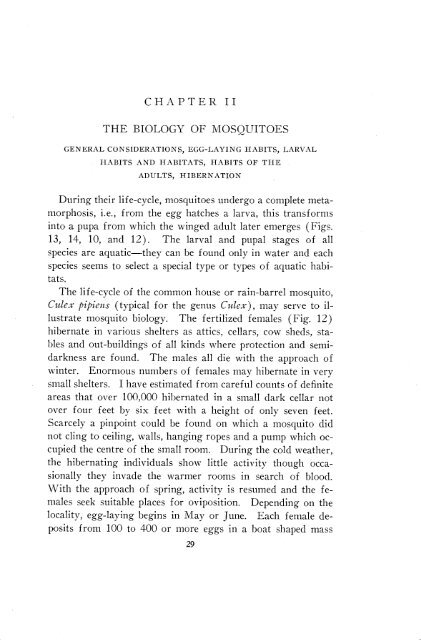a handbook of the mosquitoes of north america - Systematic Catalog ...
a handbook of the mosquitoes of north america - Systematic Catalog ...
a handbook of the mosquitoes of north america - Systematic Catalog ...
Create successful ePaper yourself
Turn your PDF publications into a flip-book with our unique Google optimized e-Paper software.
CHAPTER II<br />
THE BIOLOGY OF MOSQUITOES<br />
GENERAL CONSIDERATIONS, EGG-LAYING HABITS, LARVAL<br />
HABITS AND HABITATS, HABITS OF THE<br />
ADULTS, HIBERNATION<br />
During <strong>the</strong>ir life-cycle, <strong>mosquitoes</strong> undergo a complete meta-<br />
morphosis, i.e., from <strong>the</strong> egg hatches a larva, this transforms<br />
into a pupa from which <strong>the</strong> winged adult later emerges (Figs.<br />
13, 14, 10, and 12). The larval and pupal stages <strong>of</strong> all<br />
species are aquatic-<strong>the</strong>y can be found only in water and each<br />
species seems to select a special type or types <strong>of</strong> aquatic habi-<br />
tats.<br />
The life-cycle <strong>of</strong> <strong>the</strong> common house or rain-barrel mosquito,<br />
Culex @pieas (typical for <strong>the</strong> genus Ctilex), may serve to il-<br />
lustrate mosquito biology. The fertilized females (Fig. 12)<br />
hibernate in various shelters as attics, cellars, cow sheds, sta-<br />
bles and out-buildings <strong>of</strong> all kinds where protection and semi-<br />
darkness are found. The males all die with <strong>the</strong> approach <strong>of</strong><br />
winter. Enormous numbers <strong>of</strong> females may hibernate in very<br />
small shelters. I have estimated from careful counts <strong>of</strong> definite<br />
areas that over 100,000 hibernated in a small c1a.rk cellar not<br />
over four feet by six feet with a height <strong>of</strong> only seven feet.<br />
Scarcely a pinpoint could be found on which a mosquito did<br />
not cling to ceiling, walls, hanging ropes and a pump which oc-<br />
cupied <strong>the</strong> centre <strong>of</strong> <strong>the</strong> small room. During <strong>the</strong> cold wea<strong>the</strong>r,<br />
<strong>the</strong> hibernating individuals show little activity though occa-<br />
sionally <strong>the</strong>y invade <strong>the</strong> warmer rooms. in search <strong>of</strong> blood.<br />
With <strong>the</strong> approach <strong>of</strong> spring, activity is resumed and <strong>the</strong> fe-<br />
males seek suitable places for oviposition. Depending on <strong>the</strong><br />
locality, egg-laying begins in May or June. Each female de-<br />
posits from 100 to 400 or more eggs in a boat shaped mass<br />
29

















